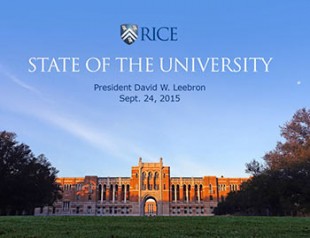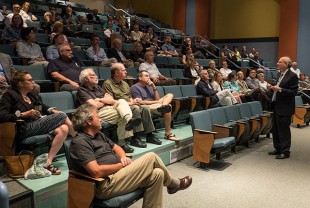President David Leebron highlighted new initiatives and a number of areas in which Rice has been successful during his 2015 State of the University address at the Faculty Senate meeting Sept. 24 in McMurtry Auditorium.
Introduced by Deputy Speaker Rachel Kimbro, Leebron noted that at a time when higher education is in “a state of turmoil which has settled down a little bit,” Rice’s mission statement continues to be “our guide for what the university is about, ought to be about and helps define our priorities.”
 Student enrollment is “an extraordinarily positive story for the university,” Leebron said. The 1,897 entering students this year are almost evenly divided among undergraduates (969) and graduate students (928) – part of the “changing complexion” of Rice, he said.
Student enrollment is “an extraordinarily positive story for the university,” Leebron said. The 1,897 entering students this year are almost evenly divided among undergraduates (969) and graduate students (928) – part of the “changing complexion” of Rice, he said.
With an undergraduate admit rate of 16 percent (compared with 25 percent 10 years ago), the university is “more selective than ever,” Leebron said. The pool of nearly 18,000 applicants, 85 percent of whom are from outside Texas, has become so good that “we are competing more with outstanding schools in the Northeast,” he said. The entering class has an “astonishing” composite median SAT score of 1475 – just one indicator of the “extraordinarily talented student body,” Leebron said.
The fall undergraduate class has the smallest percentage of Texans in Rice history – 42 percent – but still more Texans than a decade ago. The class’s overall geographic origin, which includes nearly 12 percent international students and 46 percent U.S. students from outside Texas, represents approximately “the mix of students that we aspire to,” Leebron said. Rice remains one of the most diverse elite private universities, with no ethnicity or race representing a majority of the student body. He noted Princeton Review’s recent ranking of Rice as No. 1 in the country for “race/class interaction” as an indication of the positive effect this diversity has on Rice students’ experiences.
Although the highest percentage of undergraduate applicants’ intended major has increasingly been in engineering or natural sciences, the highest number of actual undergraduate majors on graduation has been awarded in the social sciences. That significant increase in interest in the social sciences has warranted more investments in the departments of Economics and Psychology and other social sciences. Leebron also noted that one of the unintended benefits of expanding the student body may be that humanities enrollment has remained fairly consistent in absolute numbers at a time when many of Rice’s competitors are experiencing a decrease in the number of students seeking a humanities major. Overall, Rice has remained a fairly balanced university.
Graduate student enrollment has increased substantially (2,750 graduate students this fall, compared with 1,983 10 years ago) and has been slightly more than the percentage increase in undergraduate enrollment, Leebron said. Doctoral and MBA programs have seen steady increases in enrollment, but the most dramatic development has been in the Professional Master’s Program, which has provided significant resources for the departments offering those degrees.

President David Leebron presents the 2015 State of the University address in McMurtry Auditorium. (Photo by Jeff Fitlow)
Rice’s priorities for the new century still include strategic academic priorities, strategic school investments, campus infrastructure investments and administrative effectiveness and efficiency. But the Rice value proposition is changing: A survey conducted by Rice students in 2014 indicated that they see classroom instruction as only 26 percent of the value of their educational experience. While the quality of the classroom experience remains very important, they want to learn also through leadership activities, research, being mentored, civic and community engagement, entrepreneurship and international experiences, the survey showed.
Rice launched the Initiative for Students last year and has raised more than $102 million to support the types of learning that students value, including internships with alumni. “If you think connecting to your alumni base is important, we’d better do that better than anybody else because we have a much smaller alumni base than anybody else,” Leebron said.
Rice has also made other investments in teaching, such as the Center for Teaching Excellence, which more than one-third of the faculty have used since its inception in 2012. “Teaching is not something you kind of invest in once and then you just teach for the next 30 or 40 years,” Leebron said. “You have to invest constantly in that.”
The Doerr Institute for New Leaders directed by Tom Kolditz, the Moody Center for the Arts directed by Alison Weaver and the Rice Entrepreneurship Initiative directed by Yael Hochberg are among Rice’s other new investments intended to benefit students’ educational experience. The Rice Emerging Scholars Program, another recent investment, helps first-generation and underrepresented minority students succeed in science and engineering. This program increases retention at Rice and in science, technology, engineering and math majors. Another planned new investment, the proposed Quality Enhancement Program that is part of the reaccreditation process, will focus on improving experiential research opportunities.
On the graduate education front, professional master’s degrees in energy economics and global affairs are now being offered. The Graduate Student Association has a program through which about 75 graduate students are mentoring 100 undergraduate students about going to graduate school, and the Rice Center for Engineering Leadership offered its first leadership course for graduate students.
Rice has offered 30 massive open online courses (MOOCs) through the for-profit Coursera and the not-for-profit edX platforms. More than 27,000 people have received a certificate for completing a Rice MOOC. “Roughly speaking, half the number of our alumni have enrolled and completed a Rice MOOC,” Leebron said. “That’s a pretty astonishing statistic. This digital education is making more people aware of Rice around the world than they would have otherwise been.” Rice is now offering MOOCs for advanced placement courses, which reach high school students that the university is trying to recruit.
In an overview of Rice’s research programs, Leebron said the research environment has become exceedingly difficult. “We need to be more competitive in that environment,” he said, noting that more and more people are going after a fixed pool of resources. The research venture capital and grants received by Rice faculty, students and postdoctoral associates impacts the university’s success, reputation and recruitment.
For the past three years the number of research awards to Rice has been increasing, with $120 million awarded for fiscal year 2015, not counting 224 proposals that are still pending. Sponsored research revenues for fiscal year 2015 are more than $125 million (compared with $98.6 million in fiscal year 2010), and support from foundations — especially local foundations — accounts for much of that increase. Rice’s federal research revenues for fiscal year 2015 totaled $76.5 million.
The Rice Board of Trustees recently approved a $150 million plan that focuses on three strategic initiatives: research competitiveness, data science and molecular nanotechnology. The funding includes support for the research grant infrastructure, “venture” research funding, a new postdoctoral program, new faculty positions and research facilities and equipment.
Leebron noted that the $18.5 million federal grant for a Nanotechnology Enabled Water Treatment (NEWT) Center co-directed by Rice’s Pedro Alvarez will address “one of the world’s most important problems” — how to convert water from any source for residential or industrial use. The center, headquartered at Rice, is a collaboration with Arizona State University, Yale, the University of Texas at El Paso and more than 30 industry and government partners. Leebron noted that this kind of collaboration is what Rice requires to leverage the strength of its faculty.
On the campus front, recently completed projects include the George R. Brown Tennis Center and the renovation of Jones College. Among the projects underway or in planning phases are the Moody Center for the Arts, the Brian Patterson Sports Performance Center, soccer and track facilities, a parking and office building near Allen Center, renovation of the east second floor in George R. Brown Hall, a Music and Performing Arts Center and a new clean room.
Rice’s revenue has experienced “a fairly dramatic growth” over the past decade, Leebron said. The preliminary estimate for fiscal year 2015 is more than $666 million (compared with more than $363 million in fiscal year 2005) and reflects a 6.2 percent compound annual growth over the past 10 fiscal years. Leebron pointed out that although tuition increases and the expansion of the undergraduate student body by 30 percent contributed to the increase in revenue, Rice also increased its financial aid budget, resulting in a discount rate of 46 percent for fiscal year 2015.
Preliminary expenses for fiscal year 2015 are near $626.4 million, which brings the estimated operating margin (surplus/operation revenues) for the fiscal year to 5.9 percent.
Rice’s endowment has performed “very, very well,” Leebron said. The market value for fiscal year 2014 was $5.5 billion; the preliminary unaudited estimate for fiscal year 2015 is $5.6 billion.
Rice has placed highly in numerous college rankings, including No. 18 among national universities by U.S. News & World Report, No. 1 for best quality of life and race/class interaction by students surveyed by Princeton Review and the Department of Economics’ rise to No. 14 from No. 51 two years ago by College Factual. The U.S. Department of Education’s comparison of universities across the country highlighted Rice as one of 23 four-year institutions with low costs that lead to high incomes and one of 30 four-year institutions with high graduation rates and low costs for their lowest-income students.
Leebron emphasized the importance of Rice’s values — responsibility, integrity, community and excellence. “We live in an environment now which is very highly regulated, so we have to have a very strong sense of ethics, but we also have to have a very robust compliance structure,” he said. The university’s Standards of Ethical Conduct are posted on the Ethics and Compliance Program’s website. Faculty have been surveyed about what Rice can do better, and students have been surveyed about unwanted sexual experiences — a problem that universities across the country are committed to addressing more effectively. More climate surveys are planned to develop a better understanding of how faculty and students perceive the environment at Rice, Leebron said.
During a question-and-answer period, Leebron was asked about whether the size of the faculty needs to be increased to maintain Rice’s low student-to-faculty ratio now that the undergraduate student body has been expanded. He clarified that the high enrollment that has occurred in some engineering and social sciences courses is not a result of the growth of the student body. “The expansion was 30 percent, but we’re seeing some course enrollment increases of 100 or 200 percent.” The university has provided resources to bring in additional teaching faculty for the courses where student interest has increased significantly, and the university will continue to study how the faculty gets allocated as students’ academic interests change.
In response to a question about whether Rice plans to establish a campus overseas, Leebron said Rice’s international experience would be better shaped through digital education, faculty and student exchanges and research collaborations.
The slides from the State of the University address are posted on the president’s website.


Leave a Reply